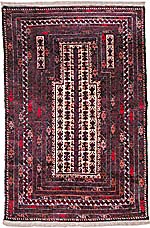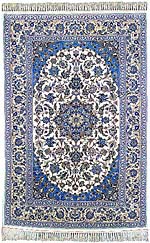Carpet Designs
A good way to categorize Oriental rug designs is not to group them by age or country of origin, but by whether they come from country or city areas.
Country Rugs…
|
|
This BALOUCH is a "country" rug.
Handspun wool pile |
Country rugs are often less tightly knotted than city rugs. Typically, their designs are more simply drawn, and are often bold and geometric.
Country rugs are usually woven of locally available materials. Many weavers, for instance, use cotton for the warp and weft of the rugs they make (cotton is less elastic than wool, and it is easier to weave a straight and flat carpet on cotton foundation). Semi-nomadic pastoralists like some Balouch and Afghans, however, use wool for their warp and weft because they do not produce cotton themselves.
Country rugs often use fewer colors (five or six) than city rugs, and some country rugs still use vegetable dyes like madder and indigo.
City Rugs…
|
|
This very fine ISFAHAN from Iran is a "city" rug. Fine machine-spun wool pile |
Cities are amalgamations of people from many different areas, and weavers working in urban areas have the chance to see many different kinds of rug designs and qualities.
City rugs are often more self-conscious rugs: the weaver is making the rug to sell, and so chooses colors and design not so much on the basis of what is traditional, but on what is likely to sell in the market.
City rugs are often the product of very specialized labor. Whereas the country weaver might build the loom, prepare and dye the wool, decide on the design, and weave and wash the rug, these functions are usually performed by different people in the city. Often there is an entrepreneur who hires designers, graph makers, dyers, weavers, and washers to make especially high quality carpets, rugs which would take too long to weave and involve too much investment for a weaver working all alone.
These City rugs are often very tightly knotted with very intricate patterns of many colors (more than ten). There is a linkage between the number of knots per sq. in. in the rug and the thickness of the pile: if a rug is very tightly knotted with an intricate design, the weaver usually clips the nap short so that the design renders with maximum clarity. Fine City rugs are often closely clipped.




